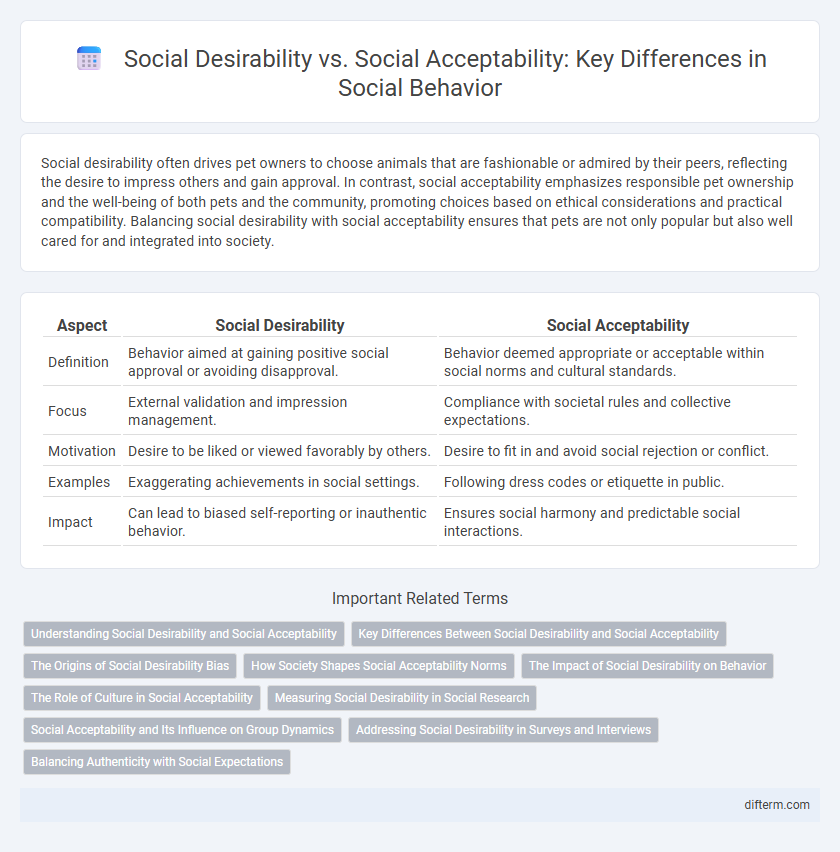Social desirability often drives pet owners to choose animals that are fashionable or admired by their peers, reflecting the desire to impress others and gain approval. In contrast, social acceptability emphasizes responsible pet ownership and the well-being of both pets and the community, promoting choices based on ethical considerations and practical compatibility. Balancing social desirability with social acceptability ensures that pets are not only popular but also well cared for and integrated into society.
Table of Comparison
| Aspect | Social Desirability | Social Acceptability |
|---|---|---|
| Definition | Behavior aimed at gaining positive social approval or avoiding disapproval. | Behavior deemed appropriate or acceptable within social norms and cultural standards. |
| Focus | External validation and impression management. | Compliance with societal rules and collective expectations. |
| Motivation | Desire to be liked or viewed favorably by others. | Desire to fit in and avoid social rejection or conflict. |
| Examples | Exaggerating achievements in social settings. | Following dress codes or etiquette in public. |
| Impact | Can lead to biased self-reporting or inauthentic behavior. | Ensures social harmony and predictable social interactions. |
Understanding Social Desirability and Social Acceptability
Social desirability reflects the tendency of individuals to present themselves favorably to gain approval, often influencing responses in surveys and social interactions. Social acceptability refers to the extent to which behaviors or ideas are deemed acceptable by a group's cultural norms and values. Understanding the distinction clarifies how personal motivation to conform (social desirability) differs from collective judgment (social acceptability) in shaping social behavior.
Key Differences Between Social Desirability and Social Acceptability
Social desirability refers to individuals' tendency to present themselves in a favorable light according to societal norms, often driven by the desire for approval or avoidance of judgment. Social acceptability reflects the broader cultural or community standards that determine which behaviors, beliefs, or traits are deemed appropriate or acceptable. Key differences include social desirability being an individual-level construct motivated by personal impression management, whereas social acceptability operates at a collective level, shaping group norms and expectations.
The Origins of Social Desirability Bias
Social desirability bias originates from individuals' intrinsic motivation to be viewed favorably within their social groups, driving them to tailor responses to align with perceived societal norms. Psychological mechanisms such as impression management and self-deception play critical roles in this bias, influencing how individuals report attitudes and behaviors in surveys and social interactions. Understanding these origins is essential for designing research methodologies that mitigate bias and accurately capture authentic social attitudes.
How Society Shapes Social Acceptability Norms
Society shapes social acceptability norms through shared cultural values, collective behaviors, and institutional influences that define what actions are considered appropriate or inappropriate within a community. Social acceptability is dynamic, evolving as societal attitudes shift due to factors such as media representation, education, and policy changes. Understanding this interplay highlights how norms are maintained or challenged, impacting social cohesion and individual behavior conformity.
The Impact of Social Desirability on Behavior
Social desirability significantly influences behavior by driving individuals to conform to perceived societal norms to gain approval or avoid judgment, often leading to altered self-reports and actions. This phenomenon can mask true attitudes and intentions, reducing the authenticity of social interactions and data accuracy in research. Understanding social desirability effects is crucial for interpreting behavior within social contexts and improving the validity of behavioral assessments.
The Role of Culture in Social Acceptability
Culture shapes social acceptability by defining the norms and values that guide acceptable behavior within a community, influencing what is considered appropriate or inappropriate. Social desirability, while linked to individual desire for approval, varies across cultures as different societies prioritize distinct traits and behaviors. Understanding cultural frameworks is essential to predict social acceptability, as behaviors deemed acceptable in one culture might be rejected in another due to divergent social values and traditions.
Measuring Social Desirability in Social Research
Measuring social desirability in social research involves assessing the extent to which respondents tailor their answers to align with perceived social norms or expectations rather than their true feelings or behaviors. Tools like the Marlowe-Crowne Social Desirability Scale and the Balanced Inventory of Desirable Responding are commonly used to detect and control for response bias caused by social desirability. Accurate measurement helps differentiate between genuine attitudes and socially influenced responses, improving the validity of social research findings.
Social Acceptability and Its Influence on Group Dynamics
Social acceptability significantly shapes group dynamics by establishing behavioral norms that members are expected to follow, fostering cohesion and reducing conflicts. When actions align with social acceptability, individuals experience increased trust and cooperation within the group, enhancing collective decision-making and productivity. Deviations from these norms often lead to social sanctions or exclusion, reinforcing conformity and maintaining group stability.
Addressing Social Desirability in Surveys and Interviews
Social desirability bias can significantly distort survey and interview responses by prompting participants to answer in ways that are perceived as more favorable or acceptable to others. Employing techniques such as anonymous data collection, indirect questioning, and validated social desirability scales helps mitigate this bias and yields more accurate data. Enhancing respondent comfort through clear confidentiality assurances and neutral question framing further improves the reliability of self-reported information in social research.
Balancing Authenticity with Social Expectations
Balancing authenticity with social expectations requires navigating the tension between social desirability and social acceptability, where individuals often modify behavior to align with perceived norms. Social desirability influences people to present themselves favorably to gain approval, while social acceptability entails adhering to collective standards that facilitate group harmony. Striking this balance fosters genuine self-expression without alienating social groups, enhancing personal integrity and social cohesion simultaneously.
social desirability vs social acceptability Infographic

 difterm.com
difterm.com